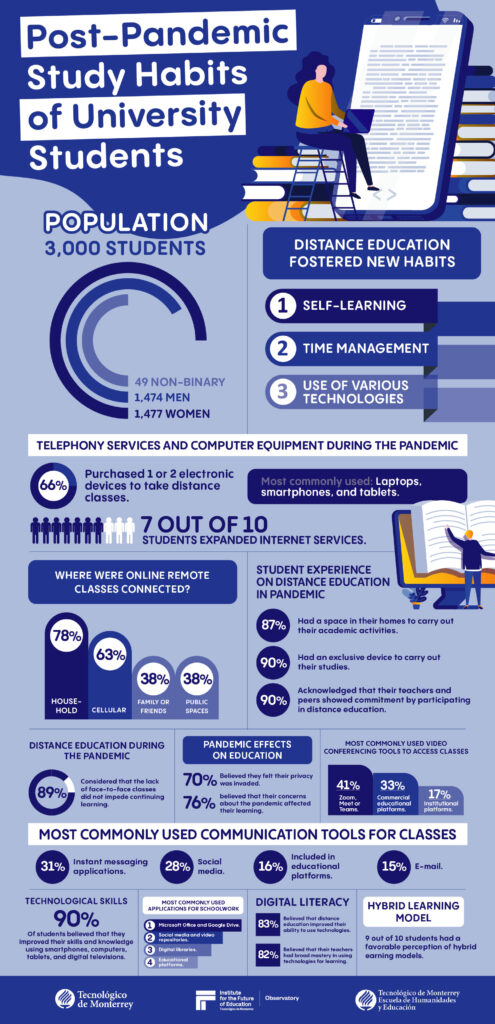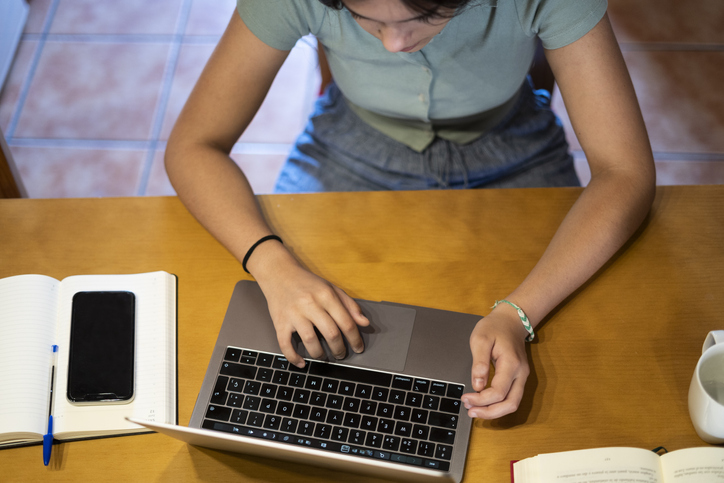Do you remember how you designed academic activities before the pandemic? COVID-19 changed the educational dynamic, causing institutions, teachers, and students to suddenly adapt to a non-face-to-face modality, adapting or creating virtual spaces so that training processes could continue (Santana Bonilla and García-de-Paz, 2020). In the Americas alone, more than 520 million students and 43 million teachers migrated to virtual scenarios, changing how they learn and teach (IESALC-UNESCO, 2020).
Study habits are the regular practices that students deploy to face the demands of the university. They are behaviors frequently used that ensure and facilitate knowledge acquisition (Peker, 2021). The pandemic generated an online learning wave that forced students to dedicate more time and energy to familiarize themselves with technological teaching platforms (Niemi & Kousa, 2020). Involuntarily students acquired particular habits related to communication devices and services to develop literacies and competencies associated with the use of technology (Cortoni & Perovic 2020).
“The need to strengthen a hybrid model that balances face-to-face and non-face-to-face learning experiences is evident. Some opportunity areas include access to digital libraries and using educational platforms.”
Research on the study habits of university students during the pandemic
The School of Humanities and Education (EHE), through the Development and Use of Technology in Education (DUTE) group at Tecnologico de Monterrey, designed and validated a questionnaire called the Survey of Study Habits of University Students 700+ days after the Pandemic in Mexico. The survey was applied in August-December 2021 semester to a representative, non-probabilistic sample of 3,000 participants from public and private higher education institutions, distributed in the six Nielsen regions of Mexico (North, Northeast, Bajío, Centro, CDMX, and Southeast). When participating in the research, the students were pursuing their university studies in educational institutions that had to migrate academic training to online learning models. The sampling technique by quotas segmented two types of subjects: 1) students from public universities (N=1500) and 2) students from private universities (N=1500).
The objective was to know the impact that the COVID-19 confinement had on the study habits of Mexican students enrolled in private and public universities in Mexico. To achieve this purpose, we formulated three specific objectives:
- Analyze the university students’ conditions of access to digital devices and applications.
- Analyze changes in digital literacy, learning experiences, motivation to learn, and school engagement.
- Analyze the effects on learning during the online training experience.
Findings on the university students’ study habits during the pandemic
The extensive survey results report will be published soon in a journal of international impact. However, here is a preview of some of the most relevant points below:

Although many students had already used various technological devices for entertainment in their daily lives (Ståhl, 2017), one of the main challenges evident during the pandemic was learning to use these devices for educational purposes. In addition, due to the unforeseen change in the study modality, students had to abandon the classroom, enable spaces in their homes, and even share their devices with other family members.
According to the survey results, virtual education led 66% of university students to acquire between one and two devices to attend classes remotely. The significant purchases were laptops, smartphones, and tablets. Also, seven out of ten students had to expand their Internet services. 78% of the students connected from home, 63% from their cell phones, 38% accessed services from the homes of family or friends, and 38% got online in public spaces.
Students accessed their classes mainly using video conferencing tools such as Zoom, Meet, or Teams (41%) and educational platforms, both commercial (33%) and institutional (17%). To communicate, they mostly used instant messaging applications (31%), followed by social networks (28%). In addition, they used formal communication tools such as those included in the educational platforms (16%) or email (15%), but to a lesser extent.
90% of the students surveyed considered that they improved their technological skills during distance education and affirmed extensive knowledge in using smartphones, computers, tablets, and digital televisions because they were the devices that enabled the continuity of their classes. The most used applications were office automation tools such as Microsoft Office and Google Drive, followed by social networks and video repositories. In contrast, the least used were digital libraries and educational platforms.
The results also showed that distance education fostered new study habits such as self-training, time management, and the ability to use various technologies. In addition, progress in digital literacy was reported. For example, 83% of respondents considered that distance education improved their ability to use technologies, and 82% saw broad mastery of learning technologies in their teachers.
Therefore, the need to strengthen a hybrid model that balances face-to-face and non-face-to-face learning experiences is evident, as requested by 9 out of the 10 university students. Upon returning to face-to-face learning, we must leverage the habits they have developed, maintain them, and encourage new ones that benefit the students.
In this regard, the students reported enjoying a positive experience during distance education. More than 87% said they had a space in their home to carry out their academic activities, and 90% of the students had an exclusive device to facilitate their studies. Also, 90% of students acknowledged that teachers and peers demonstrated commitment to participating in distance education.
The lack of face-to-face classes did not impede continuing learning, according to 89% of the respondents. 88% commented that they perceived themselves dedicating more time to participate and perform more activities in the distance modality. Some crucial details emerged; for example, 70% of the students felt their privacy was invaded, and 76% considered that their concerns about the pandemic affected their learning.
Reflection
After two years of the pandemic, students return to classrooms in person. However, the accumulation of experience and digital capital from the non-face-to-face teaching models should not be wasted because, in recent months, we have advanced using digital tools to strengthen learning like never before.
Therefore, we suggest that the newly emerged and strengthened study habits should be in presential learning modalities and eventually adapted to multimodal learning environments: face-to-face, hybrid, online, and immersive, among others. What was accomplished during the pandemic in online learning dynamics should not be at odds with what can now be done in physical spaces. In this sense, digital tools can continue to be helpful in face-to-face environments, and there is no need to segment their usage between face-to-face and non-face-to-face modalities.
These findings may help us understand the landscape to which higher and graduate education adapted. They may also be a basis for future studies that allow acquiring more information to contribute to evolving educational systems that respond to the changing environmental conditions.
What study habits did you strengthen during the pandemic? How could they help you facilitate the return to face-to-face education? Do you want to be notified when the study is published in full? Please send us an email in the comments section!
We invite you to watch the webinar and share it with your colleagues. It is available on the Observatory of the Institute for the Future of Education’s Facebook, YouTube, LinkedIn, and Twitter pages of Tecnologico de Monterrey.
About the Authors
Carlos Enrique George Reyes (cgeorge@tec.mx) is the Leader of the Development and Use of Technology in Education (DUTE) subgroup of the GIEE Educational Innovation. Also is a professor of the Master’s Degree in Educational Entrepreneurship.
Leonardo David Glasserman Morales (glasserman@tec.mx) is Director of the Master’s Degree in Educational Entrepreneurship and a Member of the Development and Use of Technology in Educación (DUTE) subgroup of the GIEE Educational Innovation. Adjunct Interdisciplinary Research Group (IRG) Researcher on Reasoning for Complexity (R4C) of the Institute for the Future of Education.
Jessica Alejandra Ruiz Ramírez Doctoral student in Educational Innovation Research Line DUTE – Development and use of technology
Francisco Javier Rocha Estrada Doctoral student in Educational Innovation Research Line DUTE – Development and use of technology
References
IESALC-UNESCO (2020). El coronavirus-19 y la educación superior: impacto y recomendaciones. http://www.iesalc.unesco.org/2020/04/02/el-coronavirus-covid-19-y-la-educacion-superior-impacto-y-recomendaciones/
Santana Bonilla, P. J., & García-de-Paz, S. (2020). La transición a entornos de educación virtual en un contexto de emergencia sanitaria: Estudio de caso de un equipo docente en Formación Profesional Básica. Revista De Educación a Distancia (RED), 21(65). https://doi.org/10.6018/red.450791
Ståhl T. (2017). How ICT Savvy are Digital Natives Actually? Nordic Journal of Digital Literacy, 12(3), 89-108. https://doi.org/10.18261/issn.1891-943x-2017-03-04
Peker, D. (2021). Factors Affecting Study Habits in Higher Education During the Covid-19 Pandemic. Anatolian Journal of Education, 6(2), 109–124. https://doi.org/10.29333/aje.2021.629a
Niemi, H. M., & Kousa, P. (2020). A case study of students’ and teachers’ perceptions in a Finnish high school during the COVID pandemic. International Journal of Technology in Education and Science.
Cortoni, I., & Perovic, J. (2020). Sociological analysis of Montenegrin teachers’ digital capital. Comunicacao e Sociedade, 37, 169-184. http://dx.doi.org/10.17231/comsoc.37(2020).2397
Edited by Rubí Román (rubi.roman@tec.mx) – Observatory of the Institute for the Future of Education at Tec de Monterrey
Translation by Daniel Wetta.
This article from Observatory of the Institute for the Future of Education may be shared under the terms of the license CC BY-NC-SA 4.0 
)
)

)